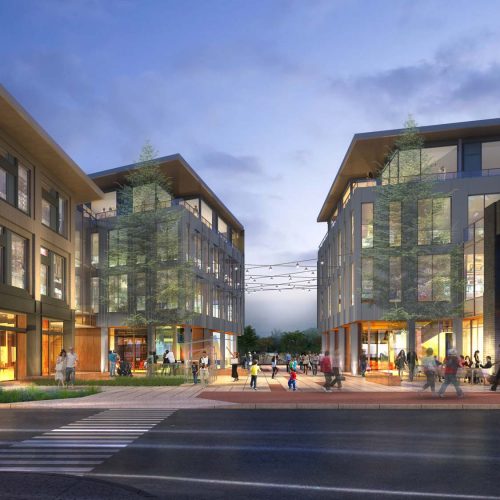
Making cents out of the “softer side” of efficient buildings
IMT and RMI’s New Green Lease Tools Help Tenants Compare Building Performance
A typical search for office space can require combing through hundreds of listings and running the numbers on rent, utility costs, insurance, and building fees in an attempt to make an apples-to-apples comparison of different market options. And then there are the less quantifiable aspects of the search: How do you factor in your personal experience of entering a building? How do you put a value on a gut feeling of whether the space feels healthy and productive, or fits your personality and lifestyle? Often—at least more than we tend to admit it—those less tangible and subjective factors determine whether or not we sign on the dotted line.
For a large commercial real estate tenant, this challenge is even more complex. In addition to budgets and other financial criteria to prioritize, many companies and organizations must factor in sustainability commitments, brands based on corporate social responsibility values, and employees who will spend more than eight hours each day in the space they select—employees whom they want to retain and keep healthy, happy, and productive. Not to mention factoring in the boards and shareholders to which many companies must answer.
“The majority of tenants have classified the fundamental challenge as this: If I’m in a high-performance building, I can see how much energy I save, but I can’t see how much productivity we’ve gained, how much we’ve reduced rates of absenteeism, and what health benefits we’ve accrued,” said Alexandra Harry, senior associate with the Institute for Market Transformation (IMT), a leading organization that works to improve the energy efficiency of buildings. “Without a number to assign to this reduction in overhead costs, it is nearly impossible to accept higher rents in a ‘green’ building.”
Thus, although a space may feel right because of the enhanced work environment it would deliver—resulting in greater employee health, productivity, retention, and attraction—the current challenge tenants face of making even basic estimates of the impact of these “soft benefits” means these benefits are most often not included in apples-to-apples assessments that tenants conduct.
Making the intangible tangible
In 2014 and 2015, RMI published a series of Deep Retrofit Value Guides for commercial building owners/occupants and real estate investors. RMI developed these to provide real estate decision makers a comprehensive methodology to make the full suite of benefits that energy-efficient buildings deliver beyond energy cost savings more tangible by tying them to dollar values and real estate metrics.
These guides show that a sustainable office space can save approximately $6.18 per square foot from employee recruiting, health insurance, and productivity-derived cost saving—and offer a process by which decision makers can conduct a detailed assessment for building spaces they are considering.
Now, IMT and RMI are arming the industry with a new set of tools that enable tenants to more effectively seek out and secure high-performance spaces that are in line with the tenant’s organizational goals, objectives, and budgets.
The Green Lease Questionnaire and Calculator—both launching next month on IMT’s website—can be used by tenants in the early stages of “house hunting” to implement green leases that save companies money on energy, and to better assess general overhead costs related to healthcare issues (due to poor indoor air quality, for example) or worker productivity loss.
The calculator and the questionnaire are independent tools for tenants to evaluate where they choose to locate in a space. The questionnaire is a list of questions for tenants to ask potential landlords about the energy efficiency and sustainability features of the building. If there are items that the building currently does not offer, it is the hope that tenants and landlords can work together to incorporate energy efficiency and sustainability upgrades through the lease.
As evidenced by IMT’s latest batch of Green Lease Leaders—announced in June at the annual conference of the Building Owners and Managers Association—an increasing number of owners are looking to green leases as a way to gain competitive advantage and differentiate themselves. The new Green Lease Questionnaire may help this process.
“The questionnaire can start a powerful conversation about sustainability and building performance between tenant and landlord groups,” said Harry. “The questionnaire provides a starting point, and a clear layout for what tenants should expect in a building that is high performance, and what measures they should consider negotiating with a building owner to make it better.”
The calculator is designed to help tenants understand the total cost of renting space in a particular building, and more easily develop a richer comparison of what savings may come from renting a space that is energy efficient. By streamlining RMI’s methodology to assess the full value of deep energy retrofits—like assigning values to health and productivity—these tools provide tenants greater ability to adopt a more holistic, yet also concrete, view of the total costs of renting space beyond dollars-per-square-foot where the “soft benefits” of high-performance spaces become part of decision-making.
Although the toolset is more effectively used when tenants are seeking out new spaces, it also can be effective in lease negotiations of already-occupied spaces, as building owners and tenants eye improvements during capital improvement cycles.
Now, IMT and RMI are looking for tenants and owners that are ready to negotiate a lease and can use the questionnaire and calculator to inform their decision-making.
“When you can use a standardized tool to demonstrate value, it becomes easier for a company to commit to better energy performance,” said Adam Sledd, IMT’s director of market engagement. “When you run the numbers, it can seem too good to be true. It will take a lot of socializing and market testing for the market to accept that these numbers and benefits are real. We need the leadership of these first movers to gain industry trust.”
Are you using the tool? Or are you are interested in personalizing the tool to make it more specific to your company? Contact us and share your experience.

